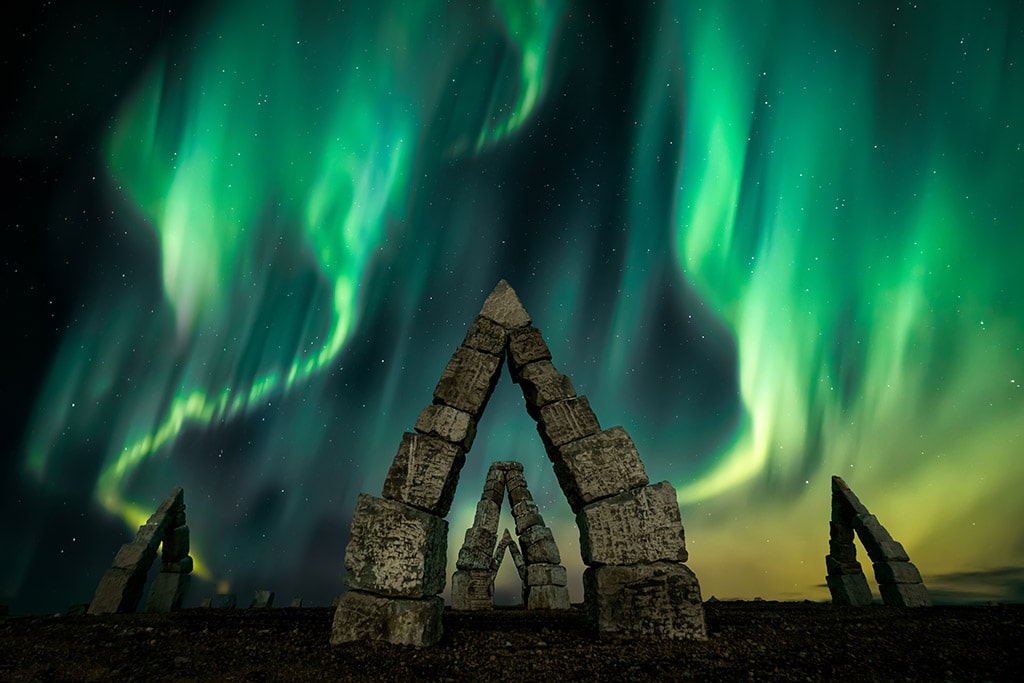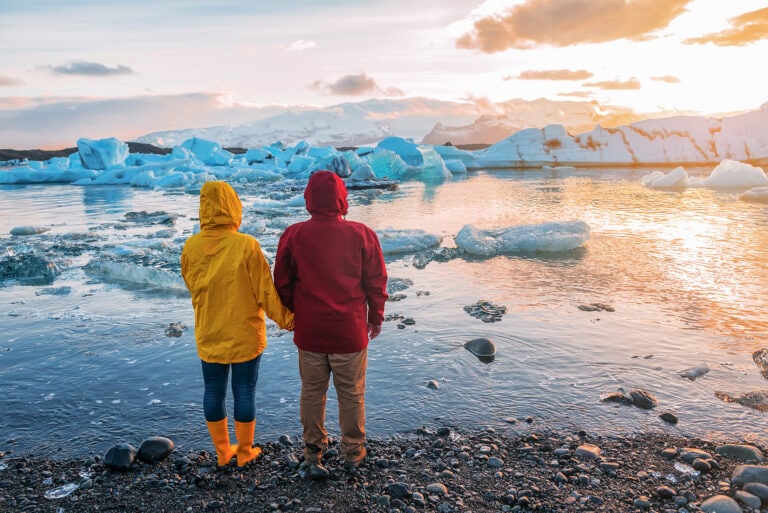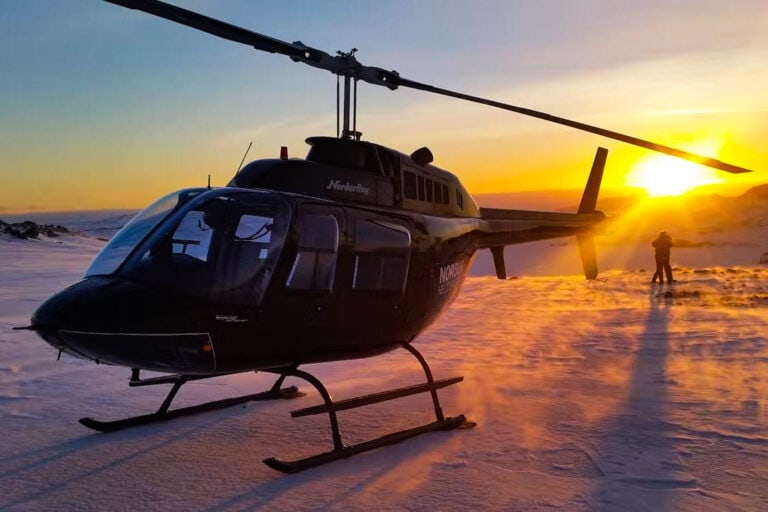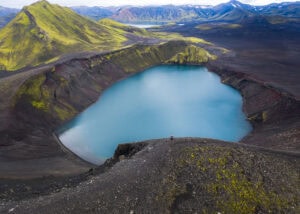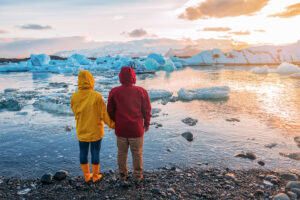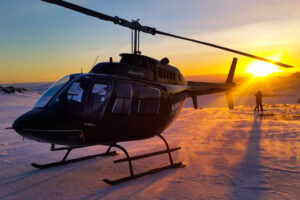Most Iceland visitors tour Reykjavík, the Golden Circle, and the country’s famed South Coast, then leave again. They’ll have a wonderful time, to be sure, but are also missing out. A stone’s throw from the Arctic Circle, North Iceland offers a remote grandeur that makes it well worth feeling like you’re at the edge of the world. Epic snow-capped peaks, lush pastures lining fjords, dramatic waterfalls and canyons, exciting volcanic history, and waters alive with dolphins, seals, and whales are yours to discover if you travel just a little further. North Iceland’s capital is Akureyri, a delightful little city once deemed “The Best Place to Visit in Europe” by Lonely Planet!
In our previous article, we’ve covered all the useful information you must know about North Iceland attractions, including its special weather characteristics, geology, infrastructure, recommended activities, and more. In the following blog post, we list the most awe-inspiring attractions we recommend you visit. Read on to learn more about both well-known and hidden gems of North Iceland.

North Iceland is a huge region, so it is commonly divided into the Northeast and Northwest. The latter is visited much more often, sitting as it does between the two largest Icelandic cities of Akureyri and Reykjavík.
The less-visited Northeast is highly underrated despite its places of interest being at least as breathtaking as those of the Northwest. For this reason, we recommend taking the time to discover both, with lots of detours from the main road. Following the quieter fjord side roads will take you to the most remote areas, where you’ll see things most visitors don’t.
Where the Best North Iceland Attractions Can be Found: The Diamond Circle
Few visitors have heard of the Diamond Circle route, the northeastern counterpart to West Iceland’s famous Golden Circle sightseeing route. Since most tourists tend to stay in the southern and western areas, the attractions of the Diamond Circle remain hidden secrets.
This driving route of 250 kilometers (155 miles) encompasses some of the most compelling sights in the Northeast. There are five main North Iceland attractions accessible via the Diamond Circle: Ásbyrgi Canyon, Dettifoss Waterfall, Godafoss waterfall, Lake Mývatn – although it’s a huge area that offers plenty to see aside from the lake itself; and the town of Húsavík.
Ásbyrgi Canyon
This characteristic, crescent-shaped canyon forms only a small corner of the remarkable Vatnajökull National Park but is one of its foremost treasures. The canyon is about 3.5 kilometers (2.2 miles) long and 1.1 kilometers (0.7 miles) wide, with dramatic cliff faces of up to 100 meters (328 feet) in height. Trees are notably scarce in Iceland, yet this canyon contains thick woodland of birch and willow, as well as larch, pine, and spruce. You can hike to a small lake named Botnstjörn. Eyjan, or “The Island,” is a 25-meter rock formation dividing Ásbyrgi for almost half its length, a truly unique feature.
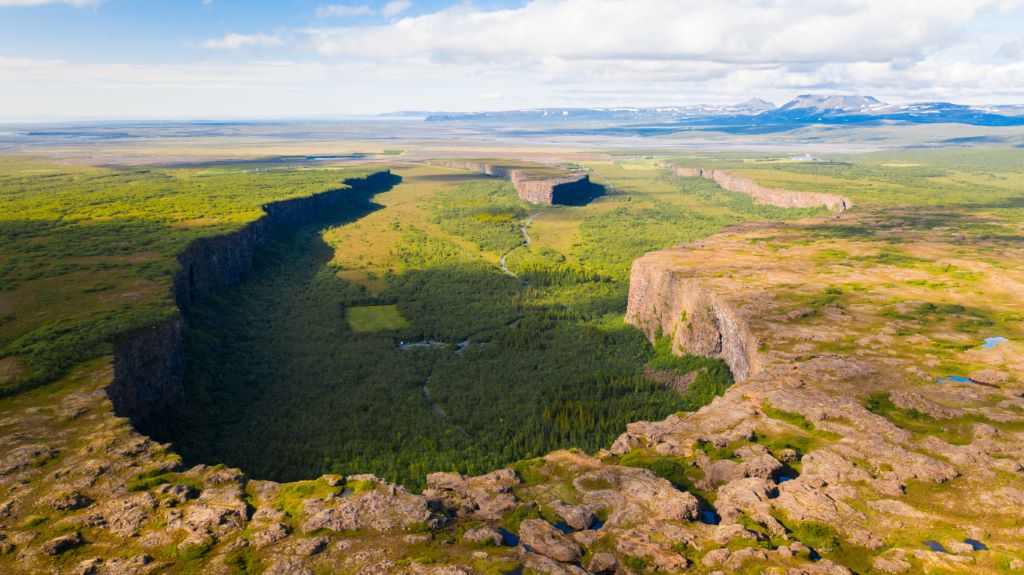
Legends, art, and literature tell of the Norse god Odin’s eight-legged steed, Sleipnir, putting one foot on the ground at Ásbyrgi, leaving a deep horseshoe-shaped imprint and creating the canyon, before sprinting back into the heavens. Other legends claim Ásbyrgi to be the capital city of the Huldufólk and elves, Iceland’s “hidden people.” Numerous Icelandic tales about these magical folk and their strange plottings and punishments are told. Thanks to the curious atmosphere of this fairy-tale forest surrounded by giant walls, Ásbyrgi is a beloved domestic travel destination for local nature lovers.
Dettifoss
This thunderous waterfall of wild white energy is the most powerful in Europe. As it is fed by the river Jökulsá á Fjöllum, flowing from Vatnajökull, the largest glacier in Europe, that may well be true. At 100 meters (330 feet) wide with an average flow of 193 meters cubed per second (6186 cubic feet), the glacial water powers 45 meters (150 feet) down into Jökulsárgljúfur canyon, in the northern part of Vatnajökull National Park. The canyon contains two other tremendous waterfalls fed by the same river, Hafragilsfoss and Selfoss.
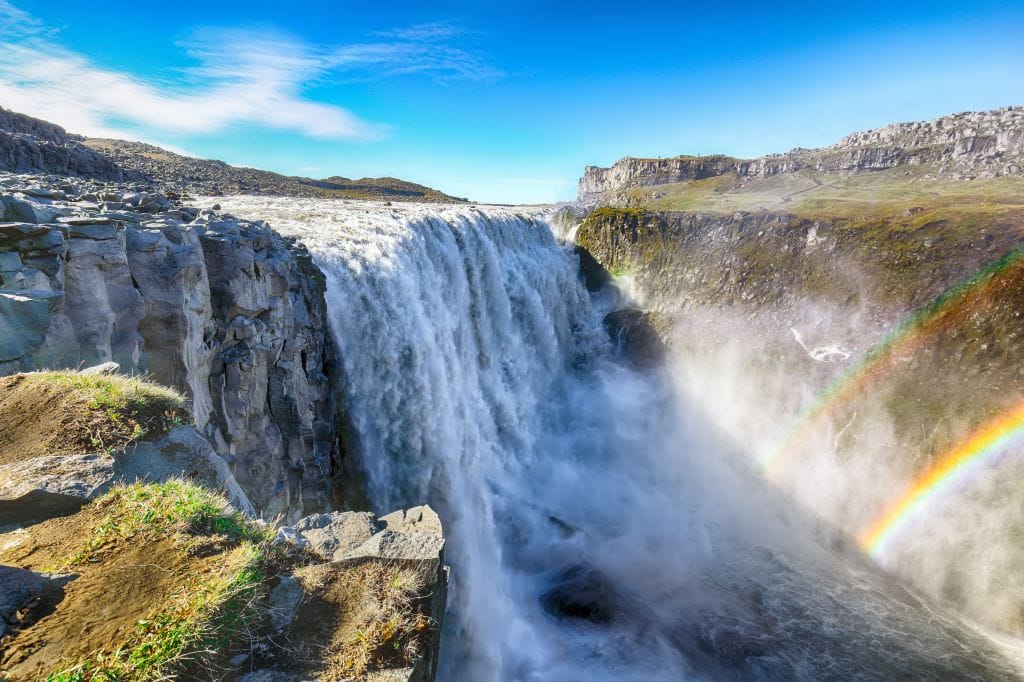
Goðafoss
Known as “the waterfall of the gods” (or of the ‘goði,’ meaning priest or chieftain), this picturesque waterfall lies along the fourth-largest river in Iceland, Skjálfandafljót. Falling from a height of 12 meters (39 feet) over a width of 30 meters (98 feet), it is one of the most breathtaking of the many waterfalls in the country.
The nicknames of Goðafoss stem from the history of Iceland’s settlement in the ninth and tenth centuries. Aside from slaves, most settlers were Norwegian, worshipping the Old Norse gods like Freya, Loki, Odin, and Thor. But in 930 AD, after the establishment of a Commonwealth, there was intense pressure to convert to European Christianity. By 1000 AD, there was fear of an invasion by Norway because the old pagan beliefs were still retained.

The parliament met at Þingvellir to discuss the matter, but the Ásatrú priest (goði), Þorgeir Ljósvetningagoði, was given the final say about what to do. He lay silently under a fur blanket for a day and a night, praying to his old gods for guidance. He arose, at last, to deliver the judgment that Christianity should be the official religion but that pagan worship could continue privately. Upon returning home, he threw idols of the Old Gods into a waterfall to mark his decision. It has been known as Goðafoss ever since.
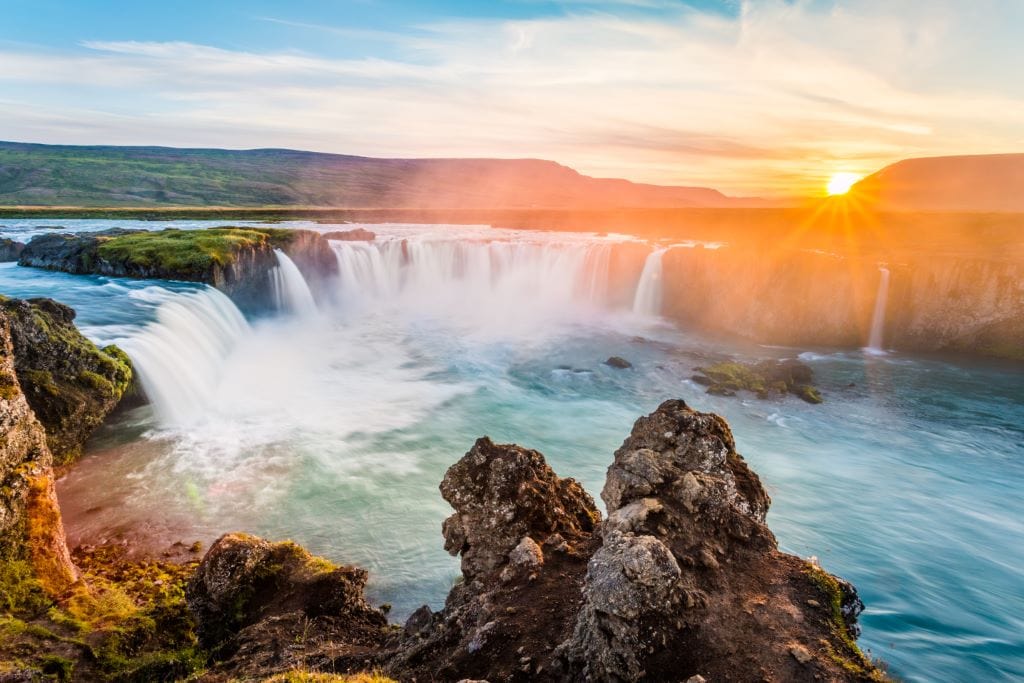
Lake Mývatn Area
This lake and its surrounding area of unearthly landscapes are probably the most popular destination in North Iceland. The lake is encircled by deep craters, smoking and bubbling hot springs, and lava fields, being itself the offspring of an eruption around 2300 years ago. There are a plethora of sightseeing opportunities, among which we most recommend:
The Námafjall Geothermal Area, also known as Hverír, is to the east of the lake, where you’ll see little vegetation but many boiling mud pots and smoking fumaroles lined by colorful sulfurous crystals. Brace yourself for the odor of rotten eggs. There is a trail for hikers to Námaskarð pass and Námafjall mountain, which bends back to the highway and parking area.
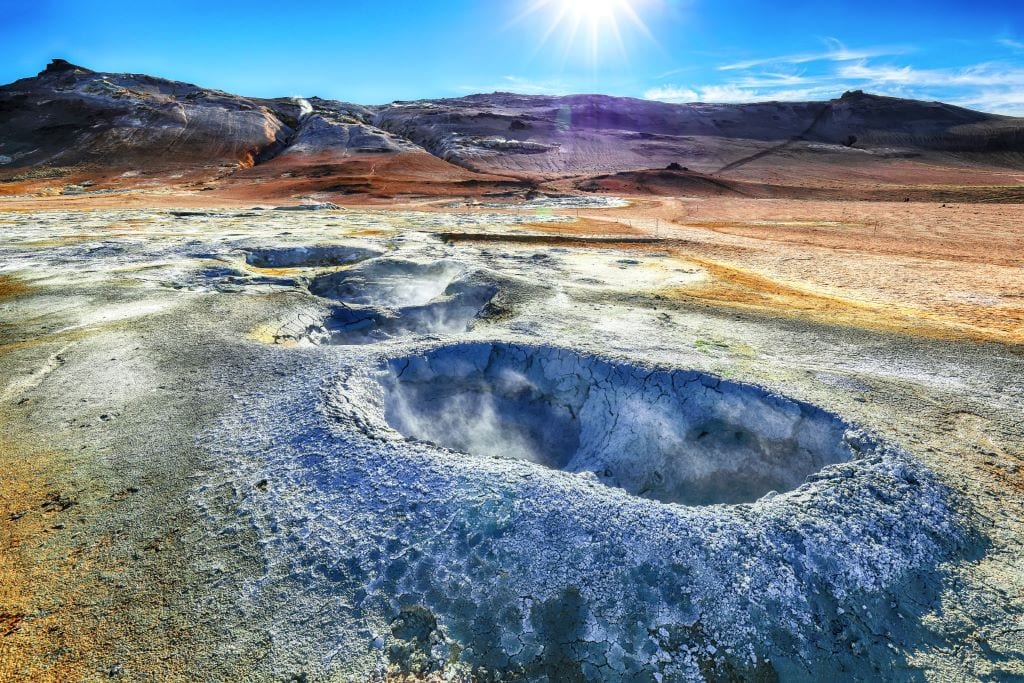
Hverfell/Hverfjall is an impressive, symmetric explosion crater surrounded by ample evidence of its activity as smaller craters, hot springs, and lava fields. At a kilometer in diameter and 140 meters deep, Hverfell is one of the largest explosion craters of its kind in the world. The country was uninhabited at the time of the eruption, around 3000 years ago. Still, like other large Mývatn eruptions, it will have created huge ash clouds that affected agriculture, temperatures, and waterways around Europe and even the world. You can hike around the crater but must stay on the path, as vegetation in such acidic areas is fragile.

Grjótagjá is a small, otherworldly lava cave used by locals as a hot spring until the 1970s when the nine Krafla eruptions from 1975 to 1984 boiled the water. The temperature has cooled over time but is still unstable, as there is magma only two kilometers (just over a mile) beneath. Bathing is, therefore, no longer permitted in Grjótagjá, though you may recognize it from an iconic love scene in the HBO series Game of Thrones.

Viti Explosion Crater is one of the two most famous Víti craters in Iceland, the other being Víti in Askja. Viti means “hell,” referring to the violence of volcanism. This Víti was formed by a massive eruption on the Mid-Atlantic Ridge, which lasted for five years; the Mývatn Fires were referred to previously. The crater has a diameter of around 300 meters. Still, it is most famous for the vivid aqua-blue coloration of the water inside it, caused by the minerals and elements that geothermal activity brings to the surface.

Dimmuborgir, also called the Black Fortress, is a dramatic and folkloric lava expanse formed by the eruption around 2300 years ago. Flowing lava passed over a lake, boiling the water but cooling more quickly, causing intense steam pillars to shatter some of it into dramatic shapes, caves, and caverns. So it gets its nickname from its resemblance to a medieval castle. A wintry Dimmuborgir was also featured on Game of Thrones. If you visit, you might look around you for a wildling army.
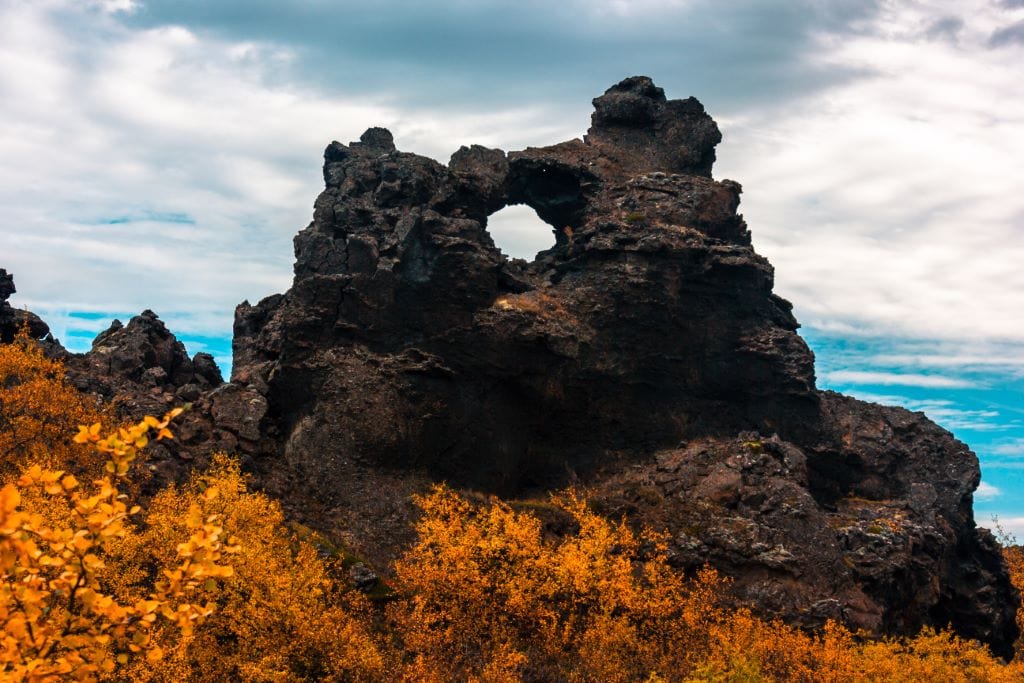
The Skútustaðagígar Pseudo-Craters are neither sources of lava nor volcanoes, so they are not viewed as true craters. As they are surrounded by the remaining wetlands of the Lake Mývatn area, it is a haven for birdwatchers, with many duck species and other birds in every season. An eruption caused lava to flow across the then-swampy wetlands of Skútustaðagígar, causing steam eruptions that created crater-like appearances.

The Mývatn Nature Baths are geothermally-heated pools and steam baths two kilometers east of the village of Reykjahlíð, which opened in 2004. Thanks to the similar characteristics of its water, being milky blue and rich in silica, the Myvatn Nature Baths are viewed as the northern alternative to the famed Blue Lagoon Spa in the southwest.
The large lagoon is about 36 to 40 degrees Celsius (97 to 104 degrees Fahrenheit) and contains many healthful minerals, especially sulfur, which are said to be helpful for respiratory and skin ailments. There is also a children’s pool, a hot tub, a buffet, and two steam baths. Be sure to hydrate before and after using the latter, as they are close to 50 degrees Celsius (122 degrees Fahrenheit) in temperature with humidity near 100% due to being situated directly over intense geothermal waters.

Húsavík
The oldest settlement in Iceland, and the main service town for the surrounding area, Húsavík is also an attraction on the Diamond Circle. The village is the ultimate departure point for whale-watching tours in Skjálfandi Bay. Húsavík is sometimes referred to as the Whale Capital of Iceland because of the incredible success rates of its whale-watching tours (over 90% in winter and over 99/ in summertime).
Charmingly, large puffin colonies can be seen in the environs of the bay, too. The local Whale Museum displays a blue whale skeleton which is 22 meters long, among other interesting artifacts.
Húsavík is more famous now than ever, thanks to the Netflix comedy Eurovision Song Contest: The Story of Fire and Saga. Will Ferrell and Rachel McAdams play siblings from Húsavík whose dream is to win the contest; the title song is also called Húsavík. You can take a Fire and Saga tour there and might recognize some of the local residents you come across if you see this charming film.
You can reach Húsavík by road, but it also has an airport. The town offers many services useful to visitors in or on its outskirts: cafés and restaurants, a brewery, a geothermal swimming pool, a golf course, and a skiing area. But probably the most enticing local amenity is a sea bath, in which you can soak and float in hot geothermal seawater while marveling at the superb view of the bay. Bliss.
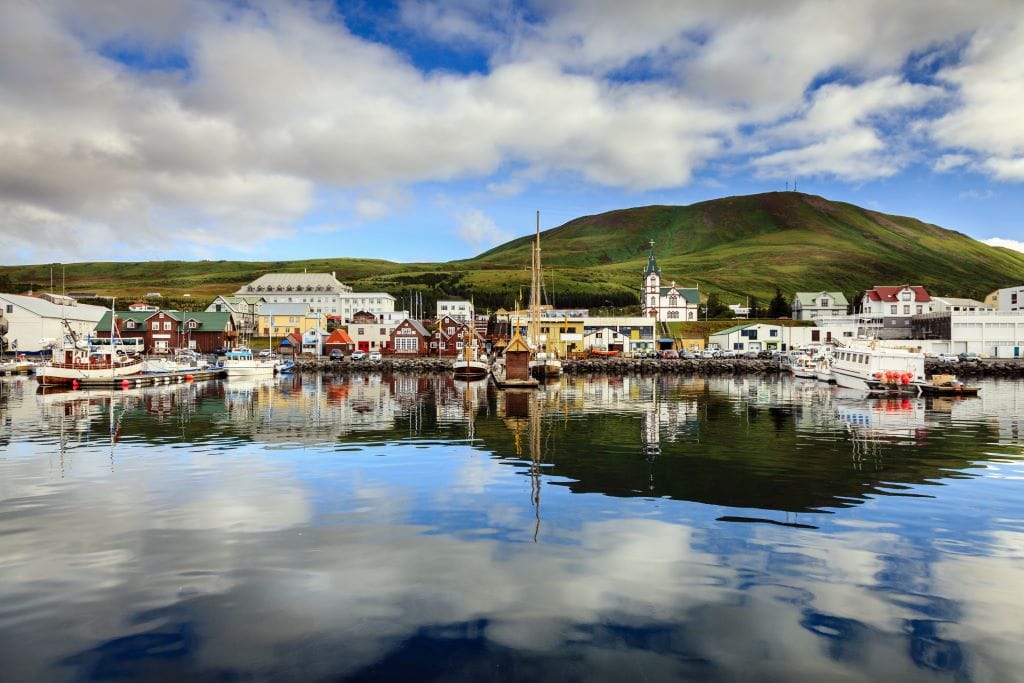
Attractions aside from the Diamond Circle
Hofsós
Dating back to the 1500s, the village is one of Iceland’s oldest trading posts. Though still a quiet fishing village, it has engineered a tourism boost by developing an outdoor swimming pool and hot pot (Sundlaugin á Hofsósi) perfectly integrated into the landscape alongside the fjord. This infinity pool gives swimmers and floaters glorious sea and sky views as they relax.

Akureyri
The ‘Capital of the North, Akureyri, sits only 100 kilometers (62 miles) from the Arctic Circle. With a population of about 17,700, the city has many excellent facilities for visitors, and it’s a short drive from there to many of the best cultural, historical, and natural attractions in North Iceland, including one of the country’s best skiing facilities. Breathtaking mountains encircle Akureyri, Kerling being the highest, with its peak at 1538 meters (5064 feet).
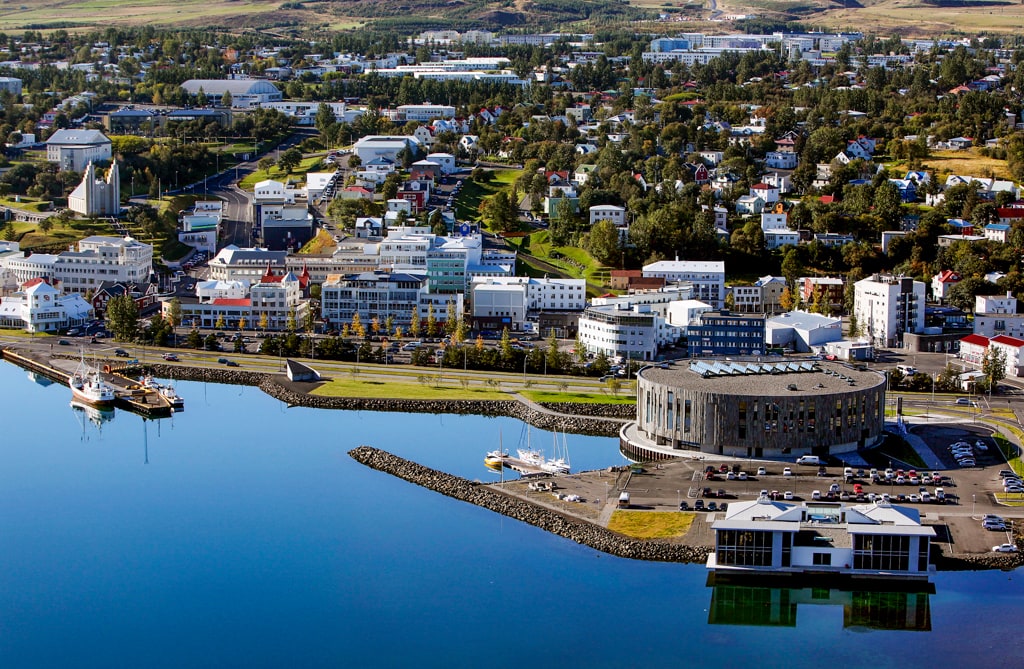
Akureyri also has much to offer those seeking a lively cultural scene, whether you’re looking for bars, concerts, highly-rated restaurants, or shows. The world’s northernmost botanical gardens are in Akureyri, near its wonderful swimming pool. The marvelous Hof concert hall, various museums, and the Christmas house (open all year) will keep you occupied and fascinated. Akureyri and its nearby towns also host fantastic summer festivals, such as the Vaka Folk Festival.
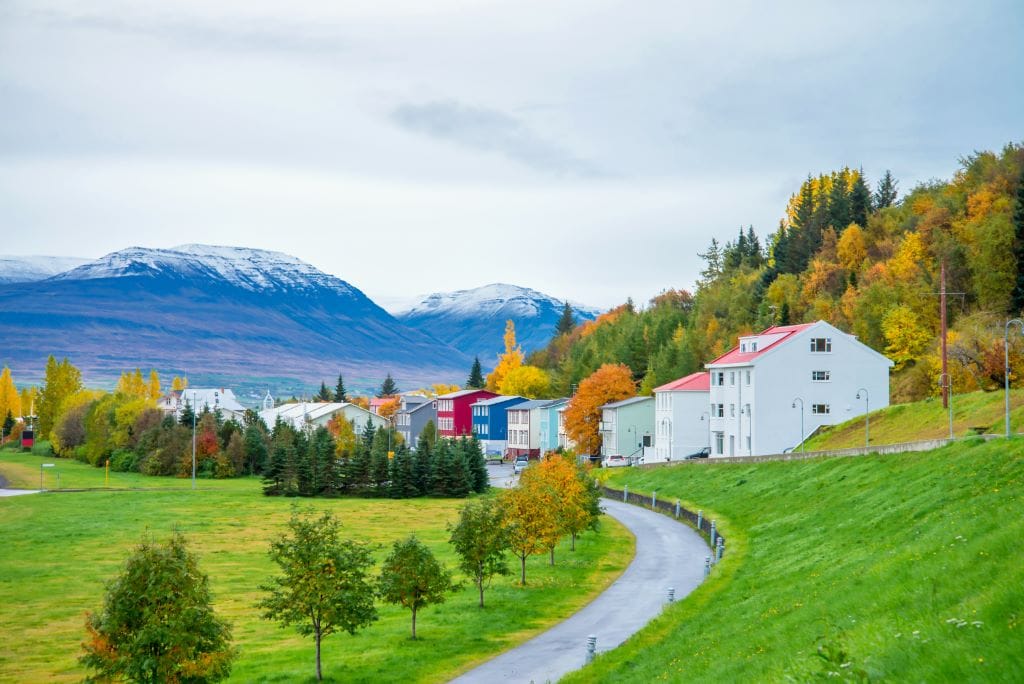
Siglufjörður
Siglufjörður village is set in an especially stunning fjord of the same name, almost dwarfed by the tall and characterful mountains looming over it. The northernmost town of the Icelandic mainland, Siglufjörður has one of the best harbors in the country, so fishing has been its main economy throughout its history.
However, as with everywhere else in Iceland, tourism and services become increasingly important to the thriving of the town year by year. ‘Twitchers’, or birdwatchers, will be especially attracted to Siglufjörður since thousands of birds, from 16 to 18 species, can be spotted in the fjord area, with summer being the best month to twitch.

Hvítserkur Rock Formation
Hvítserkur is a basalt rock stack rising from Húnaflói Bay, 15 meters (49 feet) high, and also known as the Troll of Northwest Iceland. Best viewed along the eastern shore of Vatnsnes Peninsula, it gets its name from the birdlife that nests on it: the name translates to “white shirt,” referring to the bird droppings painting the rock in white. Fulmar, seagulls, and shag all fight for space on it, so there is constant movement, making the rock seem alive.
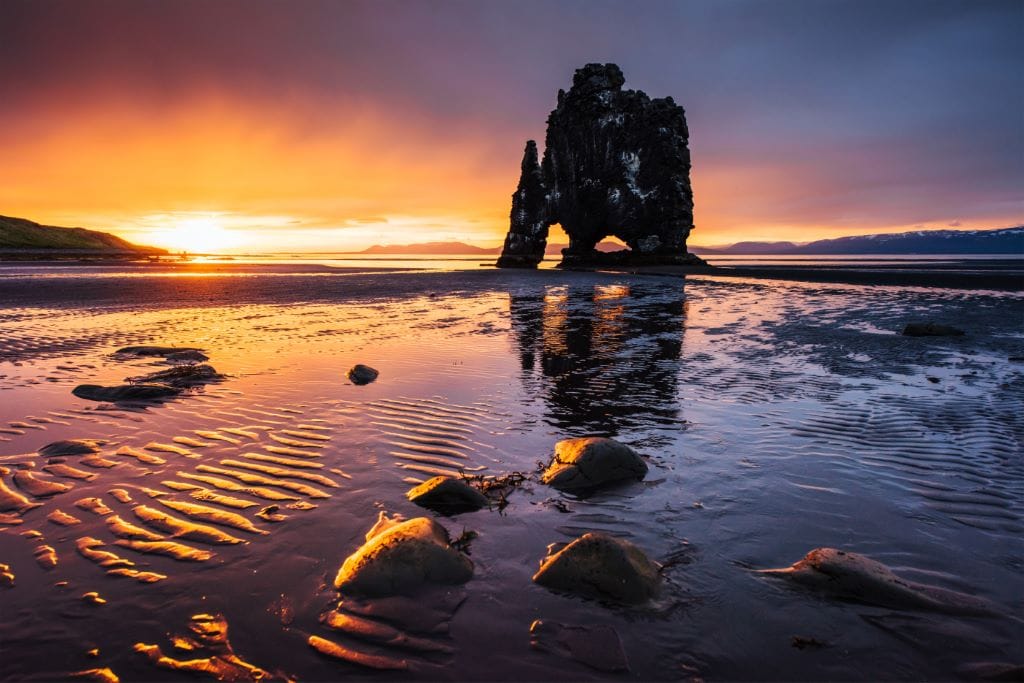
According to folklore, Icelandic elves are unafraid of Christianity, but trolls are terrified of it. Hvítserkur was a troll who traveled from the peninsula to rip the bells from the Þingeyraklaustur convent. Hvítserkur was so furious, frightened, and intent on its mission that it failed to realize the sun was rising and was turned to stone above the bay forever.
The troll nickname is not unusual, however, as it is a common name for Icelandic rock formations. It is not the folklore that attracts photographers to Hvítserkur, nor its birdlife. The way that the aurora borealis, the moon, and the sun reflect on the undisturbed water around the stone’s distinctive form is an enticing subject worth traveling a long way to capture.
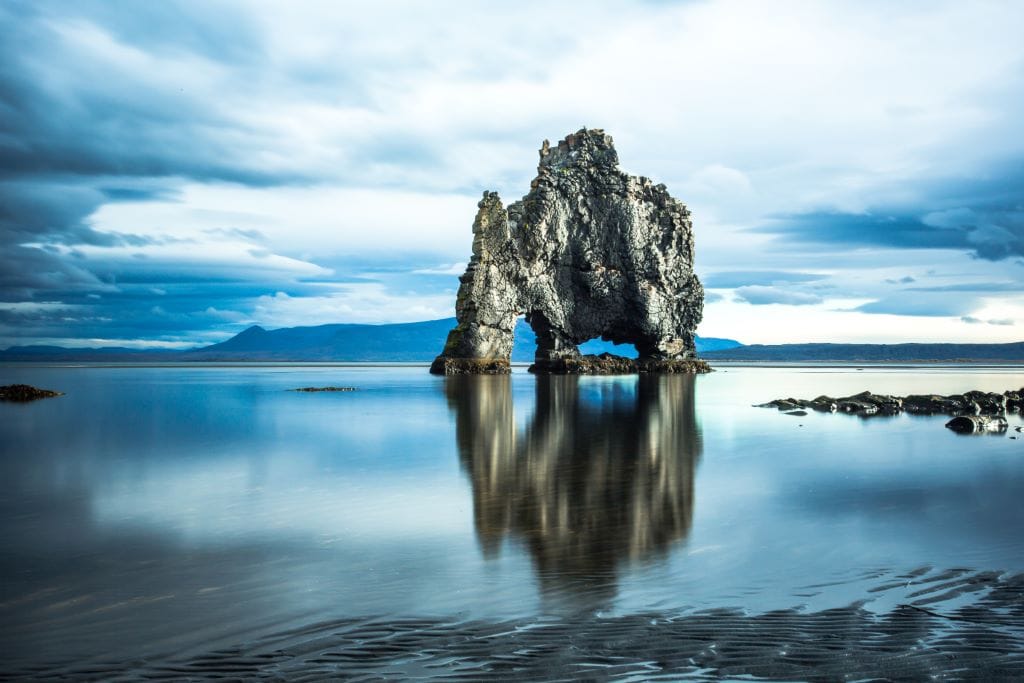
Lofthellir Cave
Lofthellir is a stunning lava cave that has permanent ice within it. The 370-meter-long cave varies in width, meaning there are sometimes open spaces where visitors can walk, but elsewhere, especially at the entrance, they must crawl. As with other natural attractions in Iceland, the eruptions that formed them brought minerals and other elements from the Earth’s mantle to the surface, which lend fascinating palettes to the cave. For example, you can see the green copper deposits, the red iron, and the yellow sulfur.
The ice of Lofthellir forms when water trickles through porous lava rock above and drips down the walls and ceilings of the cave. Because the temperature remains at around the freezing point there, even in summer, the entrancing ice structures do not melt, forming icicles that continue to grow and make Lofthellir a natural art gallery.

Askja Caldera
Located just north of the Vatnajökull glacier in the Highlands, this caldera is famous for dramatic eruptions and for having been a training area for Apollo astronauts because of its similarity to its landscape lunar terrain. The mountains which form the crater reach their zenith at 1510 meters (4954 feet), impressively high compared to most Icelandic mountains.
Askja is also home to Öskjuvatn, the second-deepest lake in Iceland, which lies around 50 meters (164 feet) below the caldera’s main floor, covers twelve square kilometers (around five square miles), and is up to 220 meters (722 feet) deep. Formed by an enormous eruption in 1875 (which sent poisonous ash across the east fjords and as far away as Poland), it is now almost always frozen. True fire and ice. Askja hasn’t erupted since 1961, but it does rumble and create tremors from time to time.
As you can imagine, Askja is a popular hiking destination, though only in summer and by people with four-wheel-drive vehicles. There are even mountain huts where you can picnic and spend the night.
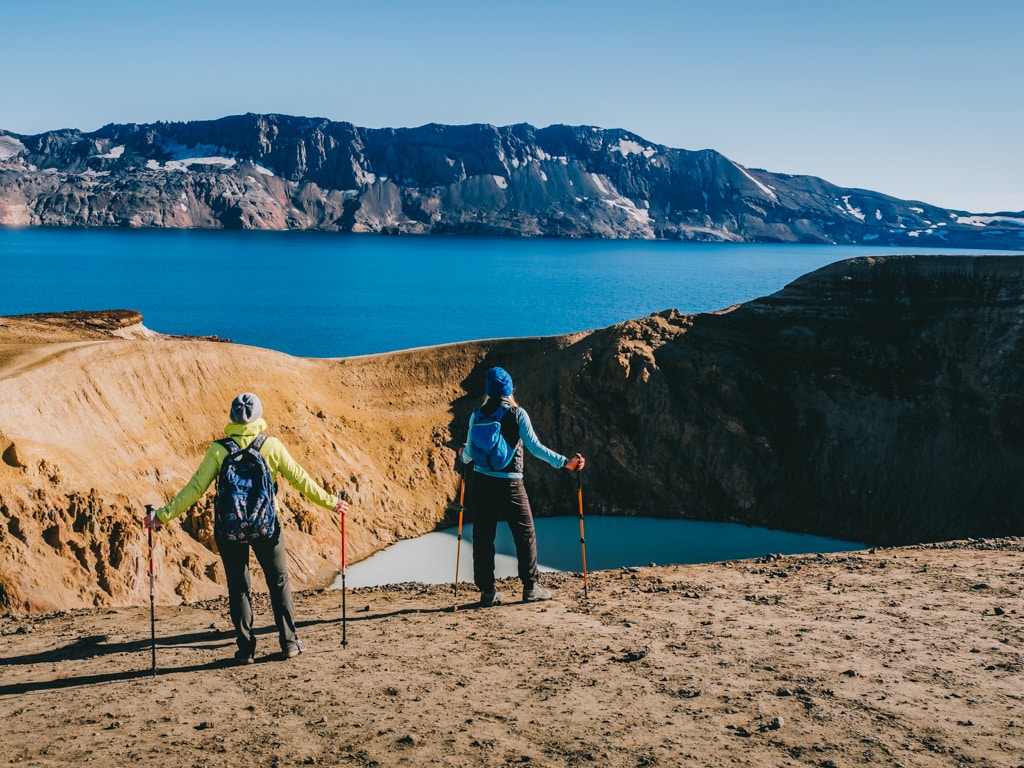
Askja is not just a caldera but also an entire region due to its size. It was formed towards the end of the last Ice Age when the Dyngjufjöll mountains in the Highlands suffered the collapse of a magma chamber beneath them so that the area fell in upon itself. This cataclysmic event formed the caldera, measuring 50 square kilometers, which became known as the Askja region.
A further eruption created other, smaller calderas inside the huge one in 1875 and expelled the massive quantities of colored ash, or tephra, that give the region its present distinctive look.
Víti by Askja
Víti is a captivating geothermal crater lake in Askja Caldera with a water temperature of 25° celsius, a heavenly place for a scenic swim. The landscape around Víti has sand dunes of jet black, giving the calming blue hues of the lake a startling and entrancing contrast to the dramatic land. You can also hike amidst the region’s astounding geology, which includes lakes and mini-craters.
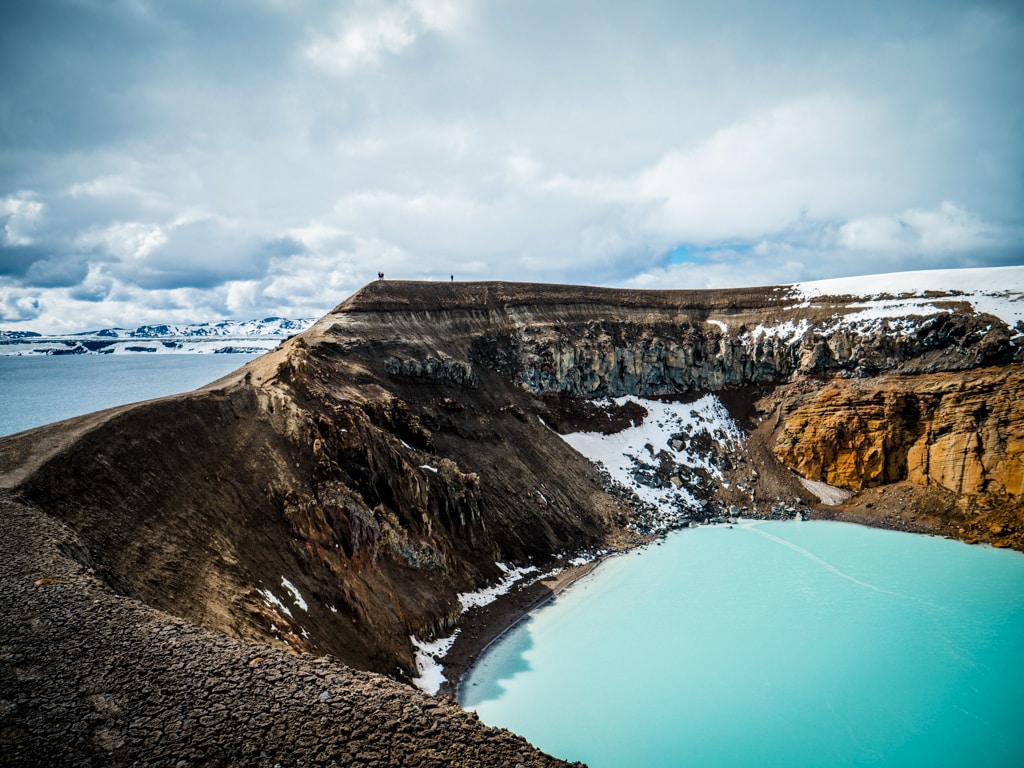
Aldeyjarfoss Waterfall
This stunning waterfall plummets twenty meters into a gorgeous blue lagoon along the Skjálfandafljót river in the northern Highlands. The highly unique geological features around it are also a draw, as it sits within rows of symmetrical hexagonal basalt columns.
During an eruption centuries ago, lava poured down Aldeyjarfoss’ cliff faces, the outer and exposed lava cooling and solidifying more than beneath. The unnatural perfection of the surrounding basalt columns results from lava having moved in such a way as to cool swiftly at a similar rate over even surfaces. This created columns, which were forced to crack by differing internal pressure levels, forming the hexagonal structures we see today. The same structures can be seen at
Other places in Iceland bear such sculptural basalt columns, including the coastal basalt formations at the famous Reynisfjara black sand beach and around the Svartifoss, “the black waterfall” in Skaftafell, South Iceland. Of the two waterfalls, the columns at Aldeyjarfoss have more interesting coloration, yellow sulfur, and red iron than the black columns at Svartifoss due to differences in the nature of the eruptions that made them.
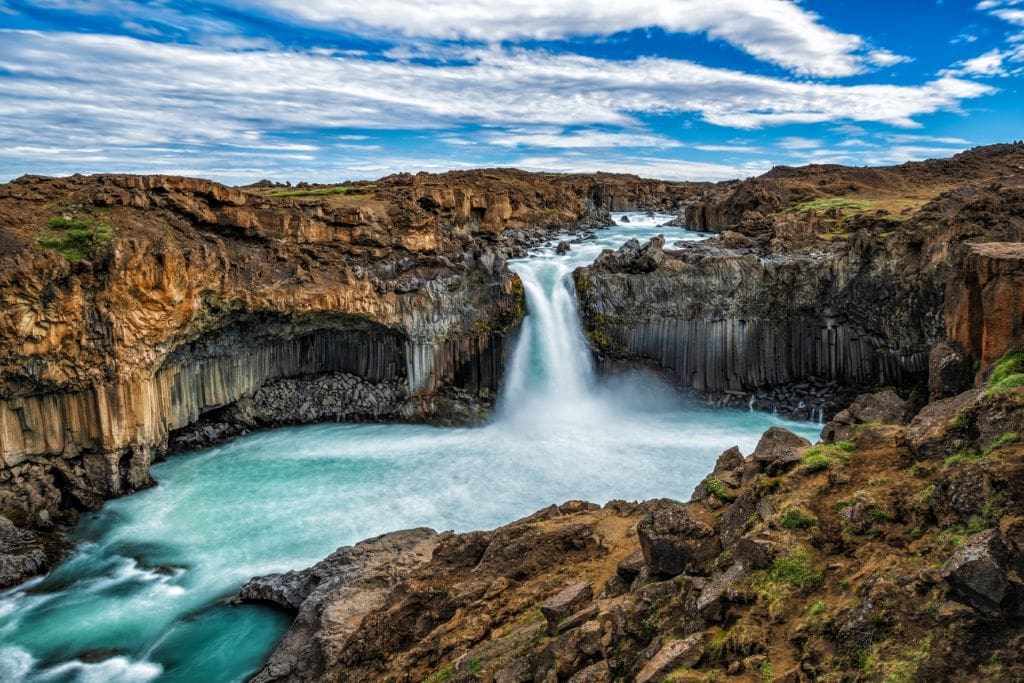
Glaumbær Turf Houses
These turf farm buildings were built in the 18th and 19th centuries and renovated in 1947. They make a fascinating and atmospheric backdrop to exhibitions detailing the farm life of that era. Two additional buildings of the 19th century, Ashus and Gilsstofa, adorn the site, Ashus also contains a lovely coffee shop. It is said that Gudridur Thorbjarnardottir, the first European mother on American soil, resided at Glaumbær during the Saga Age. This is an excellent destination for mixing mood with education.

The Arctic Henge
This monument to Norse pagan beliefs was inspired by Völuspá, a poem from the Edda, which is the equivalent of the Bible in Norse belief systems. This modern Stonehenge consists of a grand column of four pillars within four large stone arches encircled by 72 blocks. The arches are deliberately placed to catch the light of the Midnight Sun as it journeys across the sky each night in summer. The south arch is perfectly aligned with that celestial body on June 21st.
Völuspá means ‘the Prophecy of the Seeress,’ who tells in this poem of the creation of the world and its eventual doom. This encompasses the first woman and man in existence, and many mythical Norse characters, which include many dwarves. 72 such dwarves represent symbols of the seasons, and it is those beings who are symbolized by the outer blocks of the Arctic Henge, each inscribed with a name.
